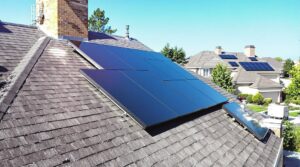Is your solar panel giving you the cold shoulder lately? Let's dive into the world of solar repairs – it's not as complex as rocket science, I promise!
Think of your solar panels like a reliable friend who suddenly starts acting weird. The telltale signs? You might notice visible battle scars (cracks or chips), your energy bills creeping up unexpectedly, or strange noises coming from your roof – like your panels are trying to start a conversation!
When it comes to fixing these sun-catching champions, you're looking at costs between $227 and $1,500. The labor costs take the lion's share at 60% – after all, these technicians are basically solar panel whisperers! The good news? Your home insurance likely has your back for those uninvited guests like wind damage, hail storms, or fire incidents.
Getting your panels back in shape involves three key steps: professional diagnosis (think of it as a solar check-up), regular maintenance (like giving your car an oil change), and proper insurance documentation (because paperwork is everyone's favorite part, right?).
Want to keep your solar investment shining bright? Regular monitoring and maintenance are your best friends. Just like you wouldn't ignore a check engine light, don't brush off those subtle signs your solar system is sending. Trust me, your wallet – and the planet – will thank you later!
Key Takeaways
Is Your Solar Panel Trying to Tell You Something? Know the Warning Signs
Think of your solar panels as silent guardians of clean energy – when they're not feeling their best, they'll show you. Those spider-web cracks spreading across the surface? That's your panel's way of waving a red flag. Watch out for mysterious color changes, sneaky burn marks, or when your energy meter starts showing lower numbers than usual.
Got a Broken Panel? Let's Talk Money
Like a trip to the doctor, fixing your solar panels comes with a price tag. You're looking at $100-$550 per panel, and here's the kicker – most of that cost (60%) goes to the skilled hands fixing them. It's like paying for the surgeon's expertise rather than the bandages.
Keep Your Solar Stars Shining
Just as you wouldn't let your car go months without a wash, your solar panels need regular TLC. A gentle cleaning every few months with soft brushes and pH-neutral solutions keeps them performing like rock stars. Think of it as giving your panels a spa day!
When Mother Nature Strikes: Insurance Has Your Back
Good news! Your standard home insurance typically plays guardian angel when nature throws a tantrum. Wind damage? Covered. Hail storm? Got you. Fire? You're protected. But here's the golden rule – document everything like a detective at a crime scene.
Claiming Success: Your Insurance Checklist
Want to nail that insurance claim? Think like a storyteller with a camera. Snap clear photos of the damage, get a pro to assess the situation, and create a report that leaves no question unanswered. It's like building a solid case for your panels!
Common Signs of Solar Panel Damage and Deterioration
Think of your solar panels as silent guardians of sustainable energy – they work tirelessly, but even superheroes show signs of wear and tear.
Like tireless sentinels of clean energy, solar panels power our homes while silently battling time and the elements.
Premium panels typically maintain 90% peak performance for their first decade of service.
Let's crack the code of panel problems together!
Visual Red Flags
Just like your skin can get sunburned, solar panels display telltale signs of distress. Watch out for:
- Spider-web cracks spreading across surfaces
- Mysterious color shifts (from sunny yellow to moody purple tints)
- Dark burn marks – nature's warning signals of electrical troubles
- Peeling layers, like old wallpaper coming loose
- Delamination, where your panel's layers decide to go their separate ways
Performance Whispers
Your panels might be quietly screaming for help if:
- Energy production takes an unexpected nosedive
- Efficiency drops faster than autumn leaves during storms
- Your utility bills start creeping up mysteriously
Beyond the Naked Eye
Sometimes the real troublemakers are invisible partners in crime. Professional inspectors use high-tech gear to spot:
- Microscopic fractures hiding beneath the surface
- Installation battle scars from rough handling
- Stress patterns from Mother Nature's mood swings
Environmental Frenemies
Your panels face a tough crowd out there:
- Relentless UV rays playing the long game
- Weather extremes throwing seasonal tantrums
- Sneaky corrosive elements mounting silent attacks
- Uninvited guests like leaves, dirt, and debris staging sit-ins
Remember, prevention beats cure!
Regular check-ups and maintenance can keep your solar investment shining bright for years to come.
Don't let small issues grow into energy-draining monsters.
Understanding Solar Panel Repair Costs
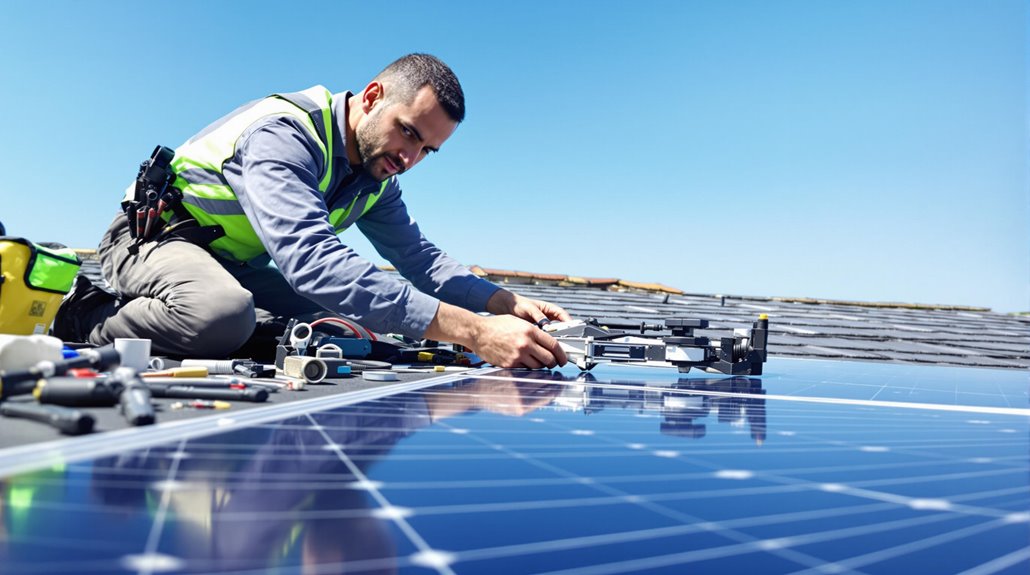
Solar panel repair costs encompass both material and labor expenses, with total costs typically ranging from $227 to $1,500 depending on damage type and system complexity.
Labor costs start at approximately $100 per hour, with variations based on roof accessibility and installation location, while material costs fluctuate according to specific component requirements.
The most significant material expenses include inverter replacements at $600-$5,500 and battery replacements at $300-$15,000, while basic panel repairs generally cost between $100-$550 per unit.
Impact-resistant surfaces help protect against hail damage and can reduce long-term repair costs by 10-15% through lower insurance premiums.
Repair Cost Breakdown
Want to Know the Real Deal About Solar Repair Costs? Let's Break It Down!
Think of your solar system like a car – sometimes it needs a quick tune-up, other times a major overhaul. While minor fixes might only set you back $20 (think loose connections or simple cleaning), those bigger repairs can climb up to $3,000, especially when dealing with complex inverter issues.
Most solar homeowners typically shell out between $400-$1,000 for common repairs.
But what's eating into your wallet? It's like a puzzle with multiple pieces: your panel's location (roof-mounted panels can be trickier to access), system size (more panels = potentially higher costs), and the type of damage you're dealing with.
Let's get specific about those repair price tags:
- Cracked glass? You're looking at $120-$500
- Need to swap out a damaged panel? Budget $150-$500 per panel
- Got wire troubles? Expect $100-$400 for rewiring fixes
Pro tip: Don't skip your annual maintenance check-up! While it might cost $150-$300, it's like getting a health check-up for your solar system – catching issues early can save you big bucks down the road. Plus, your warranty or insurance might have your back on some of these expenses, so always check your coverage first!
Remember that actual cash value coverage from your insurance will factor in depreciation when paying for solar panel repairs.
Labor Vs Materials Expenses
Ever wondered how your solar panel repair bill breaks down? Let's crack the code between labor and materials – it's like solving a home energy puzzle!
Think of labor as the maestro of your solar repair orchestra, conducting about 60% of your total costs. You're looking at skilled solar specialists who charge $100-$150 per hour, while electricians might set you back $45-$135 hourly. It's similar to hiring a skilled surgeon versus a general practitioner – each brings their unique expertise to the table.
The materials side of the equation is where things get interesting. Picture it as a hardware store shopping list that ranges from budget-friendly fixes (like a $20 bucket of epoxy) to premium investments (such as top-tier replacement panels).
When your system needs new parts, you might be looking at anything from fresh glass panels ($120-$500) to complete module swaps ($200-$550).
What really shakes up this cost dance? Enter the mighty inverter – the heart of your solar setup. These powerhouse components can tip the scales significantly, sometimes running up to $3,000.
And don't forget about those tricky installation spots! Just like a roofing project becomes more complex on a steep pitch, your solar repair costs can climb when technicians need to navigate challenging roof access or remove mounting hardware (adding up to $600 to your bill).
Most homeowners can expect their systems to maintain 80% power output for up to 40 years under standard performance warranties.
The Impact of Weather on Solar Panel Systems
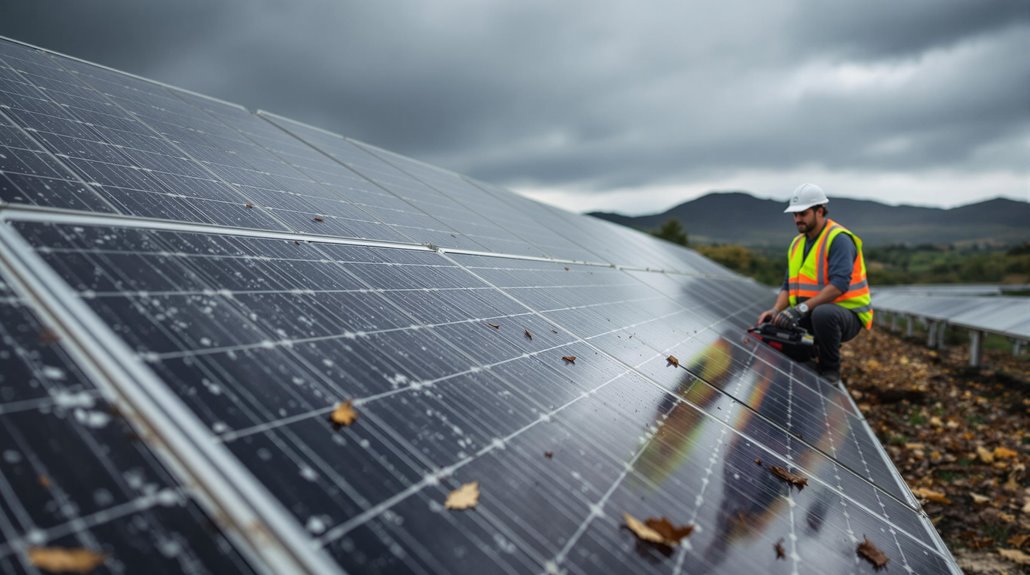
Weather conditions pose significant challenges for solar panel systems, necessitating strategic protection measures and regular maintenance schedules.
Essential protective steps include securing mounting hardware, installing proper drainage systems, and implementing automated monitoring systems to detect weather-related performance issues.
Maintenance schedules should align with seasonal weather patterns, incorporating thorough inspections before severe weather seasons and implementing preventive measures such as snow removal protocols and cleaning routines during periods of heavy rainfall.
Smart monitoring systems equipped with AI algorithms predict maintenance needs based on weather pattern impacts and system performance data.
Extreme Weather Protection Tips
Want to Weather-Proof Your Solar Investment? Here's Your Storm-Smart Guide!
Let's face it – Mother Nature's been throwing some serious curveballs lately! Your solar panels need more than just sunshine to thrive, and we're here to help you keep them performing like champions through every weather tantrum.
Think of your solar setup as a knight in shining armor – it needs the right protection to stand strong against nature's challenges.
Start with hail-resistant panels featuring reinforced glass (think smartphone screen protectors, but way tougher!) and mounting systems that can handle winds fiercer than a hurricane's temper at 140 mph.
Getting the installation angle just right is like giving your panels a built-in umbrella – snow, ice, and hail will slide right off instead of camping out up there.
But don't just set it and forget it! After every major storm, give your system a quick health check, just as you'd inspect your car after driving through rough terrain.
Smart system owners know that weather protection is a three-layer cake:
- Tough physical defenses
- Regular storm checkups
- Rock-solid insurance coverage
Did you know that each serious weather event can nibble away about 1% of your energy production? That's why investing in weather-ready equipment isn't just about protection – it's about keeping your energy harvest bountiful, rain or shine.
Weather damage protection is typically included in standard homeowners insurance policies, providing essential coverage for your solar investment.
Ready to make your solar setup weather-wise? These strategies aren't just safety measures; they're your ticket to sustainable energy production that laughs in the face of extreme weather!
Weather-Related Maintenance Schedules
Want to Keep Your Solar Panels Shining? Let's Talk Weather-Smart Maintenance!
Think of your solar panels as sun-loving athletes – they need the right training schedule to perform their best!
By syncing maintenance with your local weather patterns, you'll maximize their power-generating potential and keep them running smoothly for years to come.
Just like you'd dress differently in Miami versus Minneapolis, your solar maintenance game plan needs to match your climate's personality.
Have coastal views? Your panels might need a check-up every 3-6 months to combat salt spray.
Living where snowflakes dance? Your pre-winter prep becomes crucial – think of it as bundling up your panels for the cold season!
What's your local forecast telling you? Map out your maintenance rhythm based on:
- Rainfall patterns (because nobody likes grimy panels)
- Temperature swings (expansion and contraction need attention)
- Leaf-falling seasons (those sneaky efficiency blockers)
- Storm frequencies (when Mother Nature throws a curveball)
Pro tip: Schedule your annual inspection during fair weather, but stay flexible – sometimes your panels might need extra TLC after that unexpected thunderstorm or windstorm drops by.
Regular maintenance helps preserve your panels' 0.5% annual efficiency loss rate and ensures optimal performance throughout their lifespan.
Filing a Home Insurance Claim for Solar Panel Damage
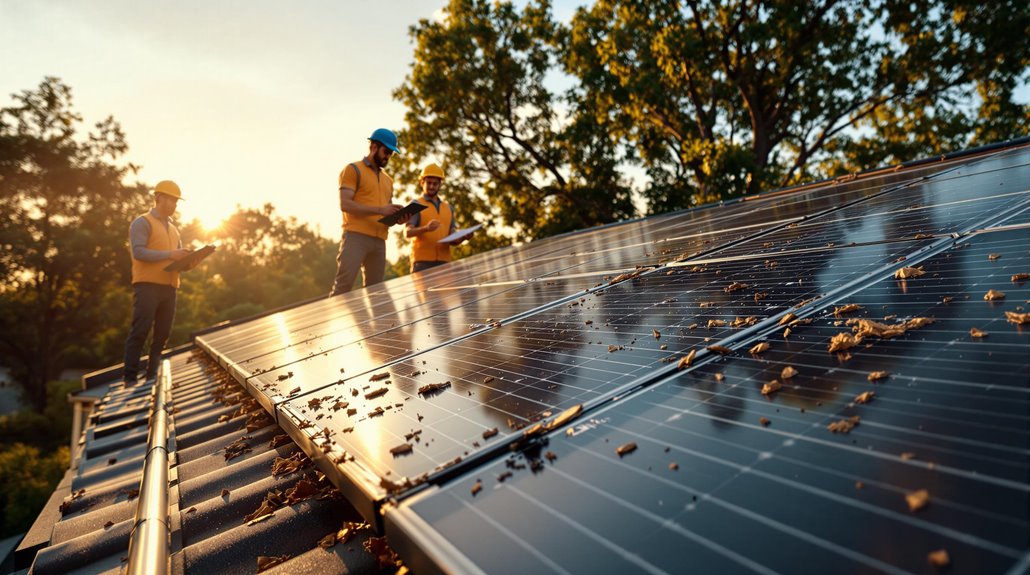
Think of your solar panels as your home's high-tech shield – when they take a hit, you need to know exactly how to bounce back. Let's walk through the insurance claim process together, shall we?
Your standard home insurance policy is likely your solar panel's best friend when it comes to common troublemakers like fierce winds, punishing hail, or unexpected fires.
But here's the kicker – every insurer dances to their own tune, so you'll want to know your policy's specific moves.
Ready to file your claim? Think like a detective! Snap clear photos of the damage from multiple angles (yes, even those tricky spots), and jot down every detail as if you're telling the story to a friend.
Your insurance adjuster will appreciate this thorough approach when they swing by for their in-person inspection.
Where your panels call home matters big time. Roof-mounted panels? They're usually covered under your dwelling insurance – think of them as part of your house's outfit.
But if you've got those ground-mounted systems, you might need to dress them up with separate structural coverage.
Most quality solar shingles are designed to withstand wind speeds up to 150 mph, but damage can still occur in extreme conditions.
Want to nail your claim? Remember these golden rules:
- Don't wait around – report damage faster than a solar panel soaks up sunshine
- Document everything like you're creating a solar panel scrapbook
- Follow your policy guidelines like they're your favorite recipe
While you're waiting for repairs, protect your panels from further damage – think of it as giving them a temporary umbrella. And hey, smart cookie, take some time to understand what your policy doesn't cover and whether you need extra protection. After all, those panels are quite the investment!
Essential Maintenance Tips for Solar Panel Longevity
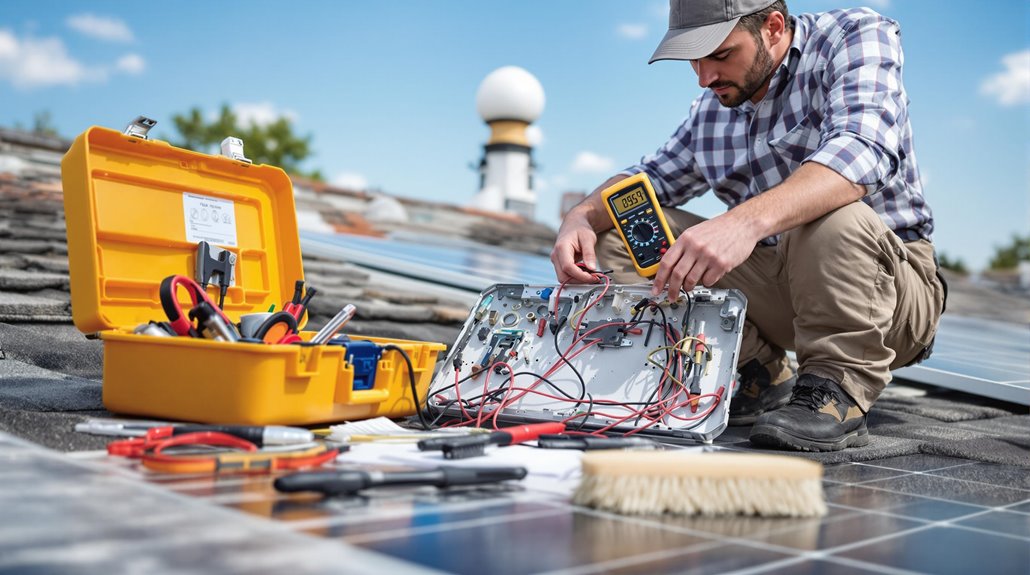
Regular cleaning with appropriate tools and safe cleaning agents maintains peak solar panel efficiency and prevents performance degradation.
System monitoring through dedicated apps or inverter readings enables early detection of efficiency drops and potential equipment failures.
Weather-related damage can be minimized through preventive measures such as snow removal with soft brushes and bi-annual inspections for coastal installations.
Regular Cleaning Methods
Want to keep your solar panels shining bright and working their best? Let's dive into the world of solar panel cleaning – it's simpler than you might think!
Think of your solar panels like windows to the sun – they need regular care to capture all that precious sunlight.
Just as you wouldn't let your car go unwashed for months, your solar panels deserve the same attention. A quick clean every 1-3 months keeps them performing at their peak and helps you spot any potential issues before they become problems.
You don't need fancy equipment to get the job done. Grab some eco-friendly soap, a soft brush (think car-washing gentle), and a squeegee with a plastic edge.
Pro tip: invest in some long-handled tools to keep your feet firmly on the ground – no risky climbing required! Deionized water is your best friend here, as it won't leave those pesky mineral spots behind.
Before you channel your inner cleaning guru, remember to power down your system – safety first! And timing is everything. Just like you wouldn't wash your car in the blazing midday sun, choose cooler moments for panel cleaning.
While robot cleaners are making waves in the industry, good old-fashioned elbow grease with the right tools still gets top marks for effectiveness.
Ready to give your solar panels some TLC? These energy-capturing champions will thank you with improved efficiency and a longer lifespan!
Monitoring System Performance
Want to get the most out of your solar investment? Let's dive into the fascinating world of solar system monitoring – it's like having a health tracker for your panels!
Think of modern monitoring systems as your solar panel's personal doctor, keeping tabs on everything from energy production to environmental conditions. You'll get real-time updates through user-friendly displays, web portals, and mobile apps that put complete system control right at your fingertips.
Your solar monitoring toolkit includes smart energy meters, weather sensors, and nifty power optimizers that work together like a well-oiled machine. They're constantly gathering data, establishing performance patterns, and sending up red flags when something's not quite right.
Ever wondered how each panel is performing? Leading platforms like Enphase Enlighten and SolarEdge give you the full scoop, down to individual module performance.
But it's not just about watching numbers tick up – these smart systems help you stay on top of warranty details and track your financial returns too. It's like having a solar-savvy assistant who never sleeps, ensuring your green investment keeps delivering maximum value year after year.
Preventing Weather-Related Damage
Want to keep your solar panels safe from Mother Nature's mood swings? Let's dive into some smart weather protection strategies that'll help your solar investment thrive for years to come.
Think of your solar panels as your home's shield against the elements. Just like you'd protect a prized possession, these energy warriors need proper armor.
A robust defense system starts with weatherproof covers that act like raincoats for your panels, keeping rain, dust, and pesky debris at bay. The star player? Impact-resistant tempered glass – your panels' personal bodyguard against hail attacks.
Storm-proofing isn't just about slapping on protective gear, though. It's like building a fortress – you need a solid foundation (installation), strategic positioning (think chess, but with panels), and a lightning defense system that'd make Thor proud.
Modern tech has our backs too, with smart algorithms calculating the perfect panel angles to dodge wind damage.
But here's the kicker – even the best protection needs a maintenance buddy. Regular check-ups and cleanings are like spa days for your panels, keeping them in tip-top shape.
Looking for extra peace of mind? Go for panels sporting UL 61730 and IEC 61730 certifications – they're the gold standard in hail resistance.
Pro tip: Keep an eye on those weather forecasts! Being weather-wise helps you stay one step ahead of storms, giving you time to deploy your protective arsenal before the sky throws a tantrum.
When to Call a Professional Solar Repair Service

Is Your Solar System Crying Out for Help? Know When to Call the Pros
Think of your solar panels as silent guardians on your roof – when they're not feeling their best, they'll definitely let you know!
Just like you'd visit a doctor for health concerns, your solar system needs professional attention when things go south.
Warning signs? Keep an eye out for these solar SOS signals:
- Battle scars: Cracked panels or shattered glass (yikes!)
- Energy output doing a disappearing act
- Your monitoring system's throwing a digital tantrum
- Strange noises or smells (solar panels shouldn't be noisy or smelly!)
Here's where solar pros become your system's superheroes. They're armed with cool tech like infrared cameras that spot invisible issues – think of it as an X-ray for your panels!
These experts don't just fix problems; they're like solar detectives who:
- Track down sneaky performance issues
- Navigate warranty mazes
- Document everything for those tricky insurance claims
- Help you decide between fixing or replacing (because sometimes, letting go is better!)
Remember, DIY might save a buck today, but professional repairs protect your solar investment for years to come.
Your panels are basically money-printing machines on your roof – wouldn't you want experts keeping them in tip-top shape?
The best part? A pro can tell you exactly what's wrong and how much it'll cost to fix, helping you make smart decisions about your system's future. It's like having a solar financial advisor and repair guru rolled into one!
DIY Solar Panel Maintenance and Safety Guidelines
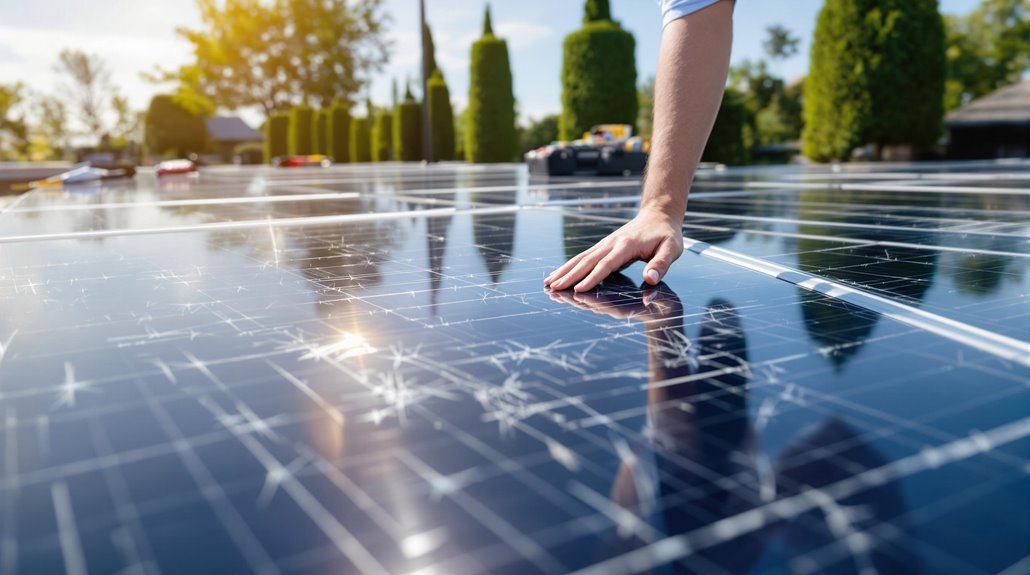
Want Your Solar Panels to Shine? Here's Your DIY Care Guide!
Think of your solar panels as sun-hungry pets – they need regular TLC to keep soaking up those rays efficiently!
Let's dive into how you can become your system's best caretaker while keeping safety front and center.
Your Solar Panel Maintenance Checklist:
🔍 Keep Your Eyes Peeled
Regular visual check-ups help you spot cracks, discoloration, or loose connections before they become energy-draining headaches. It's like giving your panels a quick health scan!
💦 Clean Like a Pro
Skip the roof acrobatics – ground-level cleaning is your safest bet. Grab these trusty sidekicks:
- A soft brush (treat those panels like delicate glass!)
- Your garden hose (no pressure washers, please!)
- Solar-specific cleaners (ditch those harsh chemicals)
- Basic safety gear (non-slip shoes and gloves are your friends)
⏰ Timing is Everything
Early bird gets the worm! Clean your panels during dawn's gentle light to avoid that shocking cold-water-on-hot-panel scenario.
🌿 Clear the Way
Keep those energy-hungry panels free from shade by trimming nearby trees and vegetation. Think of it as giving your panels their own sunbathing spot!
📝 Track Your TLC
Document every cleaning session and repair – it's like keeping a maintenance diary for your solar investment. Trust me, future-you will thank present-you for these notes!
Remember: When in doubt about any maintenance task, reaching out to a solar pro isn't just smart – it's your system's safety net!
Key Factors That Influence Repair Expenses
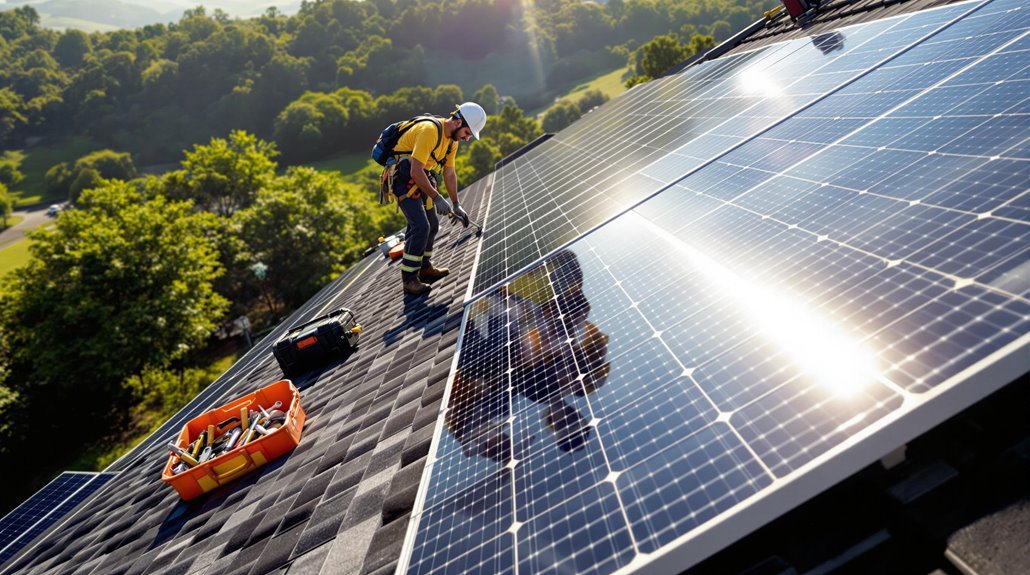
Understanding Solar Panel Repair Costs: What You Need to Know
Ever wondered why fixing your solar panels can sometimes feel like opening Pandora's box of expenses? Let's break down the four game-changing factors that influence your repair bill.
First up, location and accessibility play a huge role in your final costs. Think of roof-mounted panels like a high-wire act – they require special safety gear and equipment, which can bump up labor rates by $100 per hour.
It's like paying for a skilled acrobat who's also a solar expert!
Your system's specs are another crucial piece of the puzzle. Just as a luxury car needs specialized care, premium solar components demand expert attention and thorough inspections.
The bigger your solar array, the more comprehensive (and potentially costly) the maintenance becomes.
Then there's the terrain factor – those tricky angles and hard-to-reach spots can turn a simple repair into quite the adventure. Steep roofs? Limited access points? These challenges mean extra safety measures and more time on the job.
The type of damage you're dealing with sets the price range too. You might luck out with a simple wire fix ($100-$400), or face the need for a complete panel replacement that could run into thousands.
Think of it like comparing a minor scratch to a full engine overhaul – the complexity matters!
Want to keep those repair costs in check? Regular check-ups are your best friend, catching small issues before they become wallet-draining problems. Just like you wouldn't skip your car's maintenance, keeping tabs on your solar investment pays off in the long run.
Choosing the Right Solar Panel Insurance Coverage
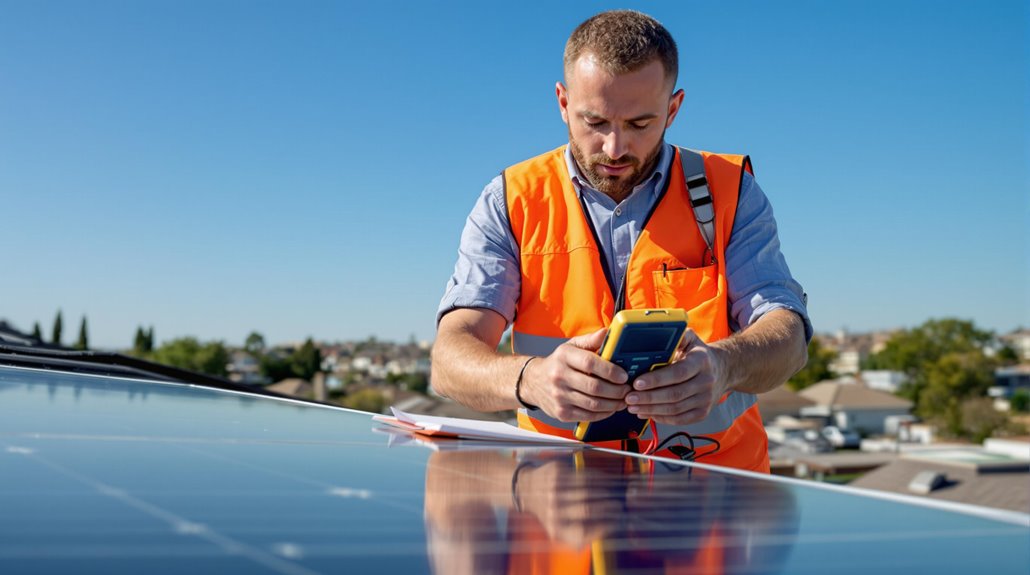
Wondering How to Protect Your Solar Investment? Let's Talk Insurance!
Your solar panels are like a mini power plant on your property – they deserve rock-solid protection.
Whether you've mounted these energy champions on your roof or planted them in your backyard, getting the right insurance coverage isn't just smart – it's essential.
Think of solar panel insurance as your safety net in three dimensions:
1. Location Matters: Are your panels soaking up sun from your rooftop or standing proud in your yard? Your coverage needs shift depending on where they call home.
Roof-mounted systems often snuggle under your existing home insurance umbrella, while ground-mounted arrays might need their own special coverage.
2. Current Coverage Check: Your home insurance might already be throwing some shade (the good kind!) over your solar setup. But here's the kicker – you'll want to look for:
- Hidden exclusions that could leave you high and dry
- Sweet spots for premium savings (hello, 10-20% discounts!)
- The fine print on leased systems
- Where your manufacturer's warranty waves goodbye
3. Future-Proof Protection: As your solar system ages like fine wine, your insurance needs evolve. We're talking about:
- Bumping up coverage limits post-installation
- Regular policy check-ups
- Exploring specialized solar insurance for that extra peace of mind
Remember, your solar panels are working hard to power your future – make sure they're protected as well as they protect your wallet!
Want to maximize your coverage? Let's dive deeper into those options.
Preventive Measures to Minimize Future Repairs
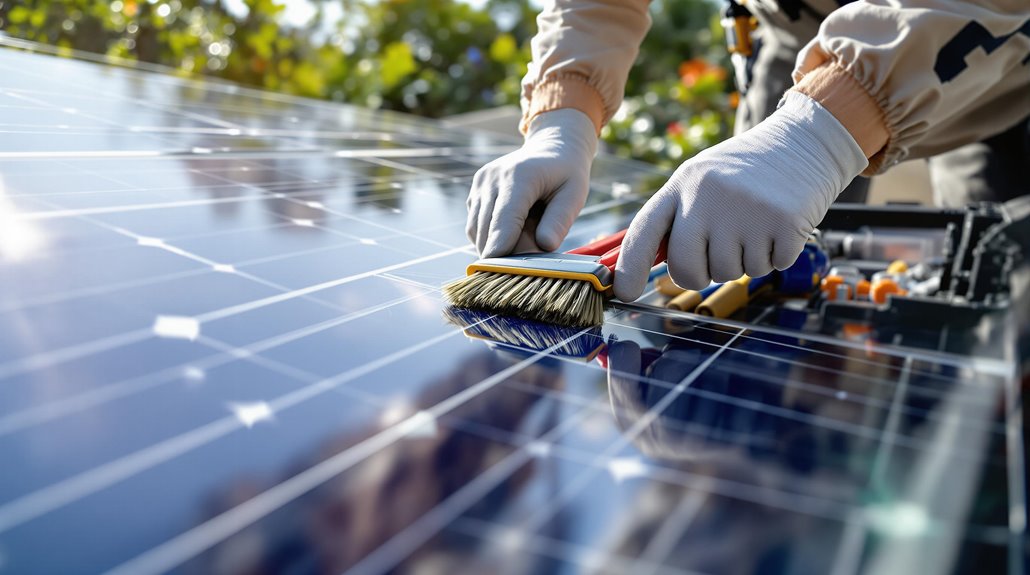
Want to keep your solar panels running like a well-oiled machine? Let's talk about smart preventive care that'll save you headaches (and money) down the road!
Think of your solar system like a premium car – it needs regular TLC to perform at its best.
Twice-yearly maintenance checks, including gentle cleaning and thorough component inspections, aren't just routine tasks – they're your insurance policy against future troubles.
Smart prevention starts right from day one. Installing high-quality components and following a systematic maintenance roadmap is like giving your solar investment a solid foundation.
Use soft-bristled tools and pH-neutral cleaners (your panels deserve the spa treatment!), keep an eye on your inverter's performance metrics, and regularly check those mounting brackets keeping everything secure.
Here's a pro tip: sync your maintenance schedule with the seasons. Just as you wouldn't wait for your car's engine to fail before checking the oil, don't wait for your solar system to show problems.
Regular system health checks can catch tiny issues before they snowball into expensive repairs.
Remember, your solar setup is like a team of marathon runners – each component needs to be in peak condition to deliver maximum energy output.
Benefits Of Public Adjusters For Solar Panel Home Insurance Claims & Questions
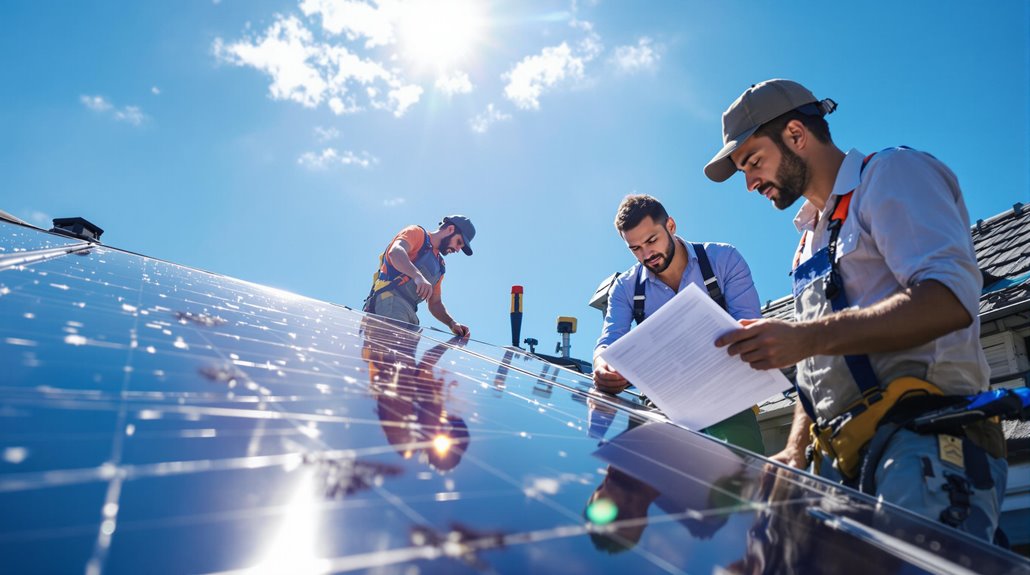
Public adjusters offer indispensable expertise in handling solar panel insurance claims through their thorough knowledge of policy coverage and professional damage assessment capabilities.
Their objective evaluations and established networks of qualified contractors guarantee accurate repair estimates and higher claim settlements for homeowners.
The streamlined claims process they facilitate, combined with their advocacy for policyholder interests, typically results in more favorable outcomes compared to self-managed insurance claims.
Expertise In Solar Insurance Policies & Claims
Protecting Your Solar Investment: A Smart Guide to Insurance Coverage
Ever wondered how to safeguard those shiny new solar panels on your roof? Let's dive into the world of solar insurance – it's not as complicated as you might think!
Think of solar panel insurance like a safety net for your sun-powered investment.
Whether you've got panels soaking up rays on your roof or standing proud in your backyard, each setup needs its own insurance strategy.
What's Your Solar Setup?
🏠 Roof-mounted systems usually snuggle right into your existing home insurance
🌳 Ground-mounted arrays might need their own special coverage
💡 Leased systems? Your provider typically handles the insurance
Smart Coverage Essentials:
- Natural disaster protection (think hail, wind, and falling trees)
- Equipment breakdown safeguards
- Theft and vandalism coverage
- Production loss protection
Pro Tips for Maximum Protection:
- Document your system's value and performance
- Snap photos during installation and regular maintenance
- Keep all maintenance records (your future self will thank you!)
- Ask about green energy insurance discounts
Red Flags to Watch For:
- Hidden policy exclusions
- Coverage gaps for newer technology
- Insufficient replacement value estimates
- Outdated policy terms
Working with an experienced public adjuster who knows solar systems can be your secret weapon when filing claims.
They speak the insurance language and fight for fair compensation when Mother Nature decides to play rough with your panels.
Expert Objective Damage & Theft Assessments
Got Solar Panel Troubles? Let's Talk Expert Assessments!
When your solar investment takes a hit – whether from Mother Nature's fury or sticky-fingered thieves – you need a pro in your corner. Think of public adjusters as your solar panel detectives, armed with cameras and expertise to crack the case of what went wrong.
These solar sleuths bring more to the table than just a keen eye. They're well-versed in every quirk and vulnerability of your rooftop power plants, from hail damage to sophisticated theft schemes.
Just like a doctor examining a patient, they'll diagnose every scratch, crack, and missing panel with precision.
Why does this matter? Because when you're dealing with insurance claims, details are your best friend. Public adjusters speak the language of insurance companies fluently, knowing exactly how to document and present your case.
They'll navigate the maze of policy terms while keeping your interests front and center.
Picture them as your personal advocates, methodically building your case with:
- Crystal-clear photo documentation
- Professional damage assessments
- Detailed theft incident reports
- Expert testimony when needed
By weaving together solid evidence and industry expertise, these specialists help ensure you don't get shortchanged on your claim. After all, your solar investment deserves nothing less than a fair shake when disaster strikes.
Remember: A thorough assessment today means better protection tomorrow. Ready to get your solar panels back in prime condition?
Streamlined Claim Process
Ever felt lost in the maze of solar insurance claims? Let's make it crystal clear! Think of public adjusters as your personal GPS through the complex world of solar claim navigation.
Why Your Solar Claim Needs a Pro's Touch
Navigating solar insurance claims doesn't have to feel like rocket science. Public adjusters are your secret weapon, turning what could be a headache-inducing process into a smooth journey.
They're like having a translator who speaks fluent "insurance-ese" right by your side!
Smart Solutions at Your Fingertips:
- Breaking down policy jargon into plain English
- Creating bulletproof damage documentation
- Acting as your direct line to insurance companies
- Fine-tuning your coverage for optimal protection
- Fighting in your corner during negotiations
But wait, there's more to the story! These solar claim experts don't just stop at the basics. They're well-versed in the whole solar ecosystem – from warranty puzzles to tax mazes and maintenance must-knows.
Whether your panels are soaking up sun from your roof or standing proud in your yard, they know exactly how to maximize your claim's value.
Think of them as your solar insurance superheroes, equipped with the knowledge to transform complicated claims into winning outcomes. Ready to turn your solar claim confusion into clarity?
Higher Claim Payouts & Settlements
Want to Get the Most from Your Solar Panel Insurance Claim? Let's Talk Strategy!
Ever wondered why some homeowners nail their insurance claims while others struggle? The secret often lies in having a professional public adjuster in your corner. Think of them as your personal insurance claim champions, working tirelessly to maximize your settlement – and they only get paid when you do!
What makes these solar insurance wizards so effective? They're like master chess players, strategically navigating the complex world of policy details and coverage requirements.
With solar installations representing a significant investment (typically $10,500 to $14,700 after tax incentives), you'll want someone who knows exactly how to document every scratch, crack, and malfunction.
Did you know that ground-mounted systems need different coverage than roof installations? That's where specialized expertise comes in handy. These pros can uncover hidden gems like eco-friendly discounts you might not even know exist.
Plus, they handle all the headache-inducing paperwork while you focus on what matters most – getting your solar system back up and running.
Can't tell your comprehensive coverage from your specialized riders? No worries! Public adjusters speak "insurance-ese" fluently and can translate those mind-boggling policy terms into plain English.
They'll fight to ensure your settlement covers every penny needed for repairs or replacement, making the entire claims process feel less like climbing Mount Everest and more like a walk in the park.
High Quality & None-Biased Network Of Trusted Solar, Roofing, & Home Contractors
Looking for trusted solar, roofing, and home improvement pros? Let's talk about how top-notch contractor networks really work!
Think of public adjusters as matchmakers in the construction world – they've built relationships with the cream of the crop in solar installation, roofing, and home repairs. But don't think it's just a casual handshake deal – these partnerships go through some serious vetting.
What makes a contractor worthy of the "trusted" stamp? It's like getting into an exclusive club:
- Real-deal licenses and certifications (no shortcuts here!)
- Proven track record of happy homeowners
- Up-to-date knowledge of local building codes
- Specialized solar and roofing expertise
- Rock-solid reliability scores
Why does this matter to you? When you're dealing with property damage or planning home improvements, you want experts who'll get it right the first time.
These pre-vetted contractors don't just fix things – they document everything meticulously, making your claims process smooth sailing.
The best part? You're not just getting random recommendations. Every contractor in these networks is constantly evaluated, kind of like a ongoing quality check at a five-star restaurant.
They have to maintain their A-game to stay in the network, ensuring you get consistent, top-tier service every time.
Want to know if your contractor makes the cut? Ask about their network affiliations and recent project history – the proof is in the pudding!
About The Public Claims Adjusters Network (PCAN)

Think of PCAN as your insurance claim superhero squad! We're a nationwide network of licensed public adjusters who stand in your corner when property damage strikes. Unlike those insurance company adjusters, we're 100% independent – meaning we work for you, not them.
Ever felt lost in the maze of insurance jargon? That's where we shine! Our network members are like property damage detectives, diving deep into complex policies to uncover every benefit you're entitled to.
Whether it's a damaged roof, flooded basement, or those fancy solar panels on your home, we've got your back.
"But how do I know I can trust these adjusters?" Great question! Every PCAN member is thoroughly vetted, licensed, and certified in their respective states. We're like a quality-control task force, ensuring you get top-notch professionals who know their local insurance landscapes inside and out.
The best part? You don't pay unless we win! Our adjusters work on contingency, which means their success is tied directly to yours. It's like having a partner who's invested in maximizing your claim – because that's exactly what we are!
We'll analyze your policy, document the damage, and negotiate with insurers using our insider knowledge of settlement strategies.
Want to know a secret? Insurance companies often settle claims for way less than they're worth. But with a PCAN adjuster by your side, you've got an expert who knows exactly how to level the playing field and fight for what you deserve. Ready to turn the tables on your insurance claim?
Frequently Asked Questions
Can Solar Panels Be Repaired if They Get Damaged by Hail?
Solar panels with hail damage typically require replacement rather than repair, as their integrated design and hail resistance features make individual component repairs impractical and cost-prohibitive using conventional repair techniques.
What Is the Average Lifespan of Solar Panel Inverters?
Solar panel inverters exhibit average lifespans between 10-20 years, with replacement intervals varying by type: string inverters lasting 10-15 years, while microinverters demonstrate extended inverter longevity of 15-25 years.
Do Solar Panels Work During Power Outages?
Like a severed lifeline, standard solar panels cease functioning during outages due to grid limitations. Continuous power requires specific backup requirements: battery storage systems or specialized inverters for operational capability.
Can Extreme Temperature Fluctuations Permanently Damage Solar Panels?
Extreme temperature fluctuations can cause permanent solar panel damage through thermal expansion of materials, insulation degradation, and microcrack formation, leading to reduced efficiency and potential system failure over time.
Are Secondhand or Refurbished Solar Panels Worth Considering for Replacements?
Secondhand panels cost 50-75% less than new ones, making them financially attractive. However, efficiency losses and reliability concerns must be weighed against initial cost savings when considering refurbished alternatives.
References
- https://1by1roof.com/tell-tale-signs-your-solar-panel-needs-repair/
- https://www.in.gov/oed/files/Good-Questions-Project-Phase-2-Final-Report-IUPUI.pdf
- https://www.ankersolix.com/blogs/solar/solar-panel-repair
- https://www.ipcc.ch/site/assets/uploads/2018/03/SRREN_FD_SPM_final-1.pdf
- https://aresolar.com/identifying-red-flags-signs-your-solar-panel-pv-system-needs-repair/
- https://www.solar-electric.com/learning-center/top-10-signs-of-solar-panel-degradation/
- https://www.bluettipower.com/blogs/articles/solar-panel-repair-how-do-i-know-if-my-solar-panels-are-damaged
- https://www.aztechsolar.com.au/6-signs-that-you-need-to-replace-your-solar-panels/
- https://findthehomepros.com/understanding-solar-panel-damage-causes-and-prevention/
- https://www.greenlancer.com/post/common-solar-panel-defects

